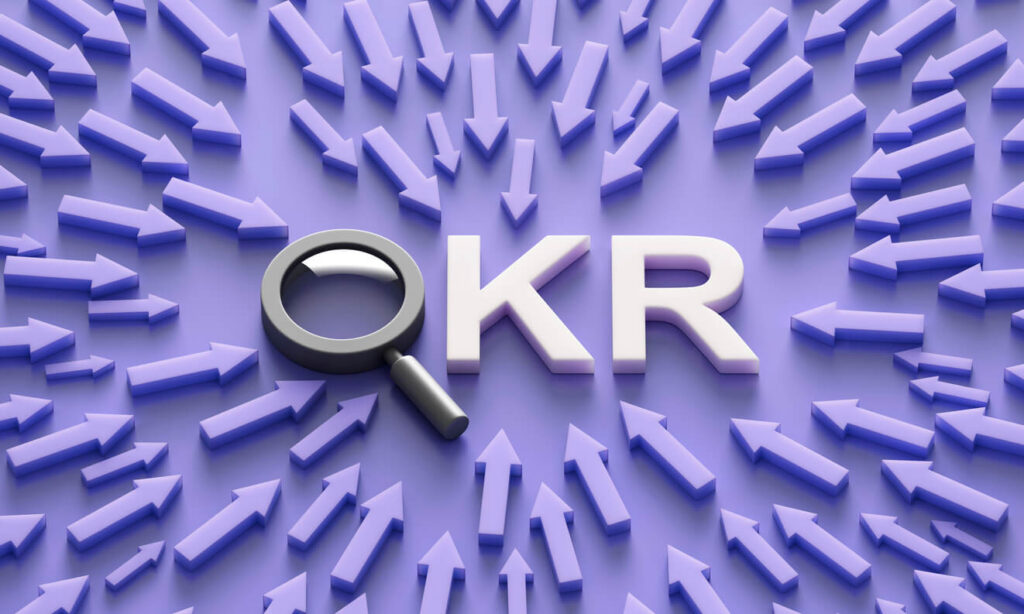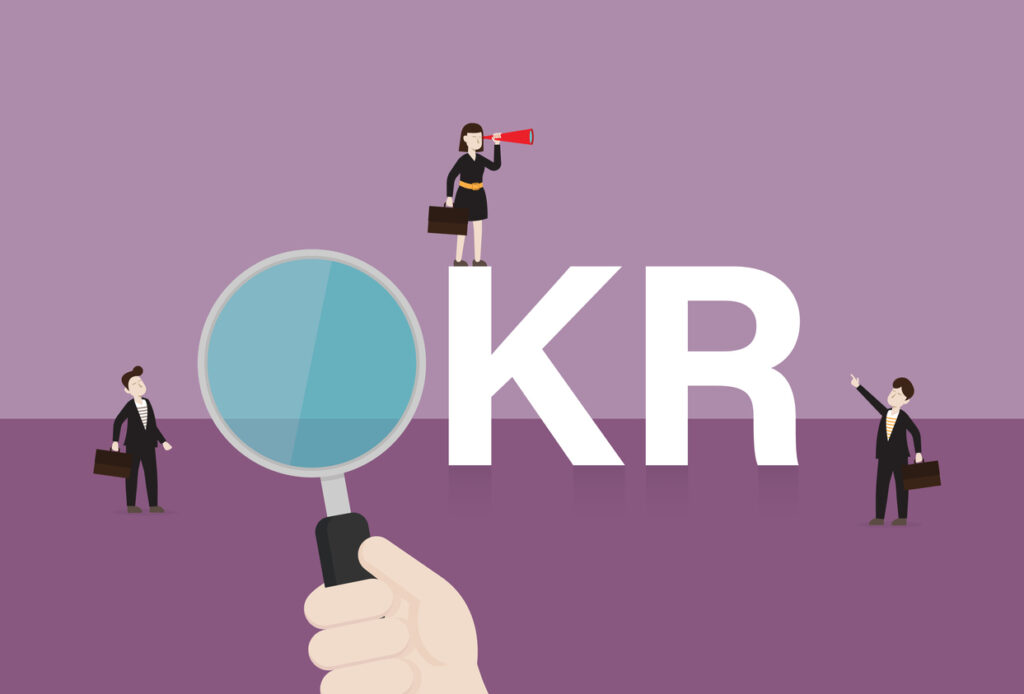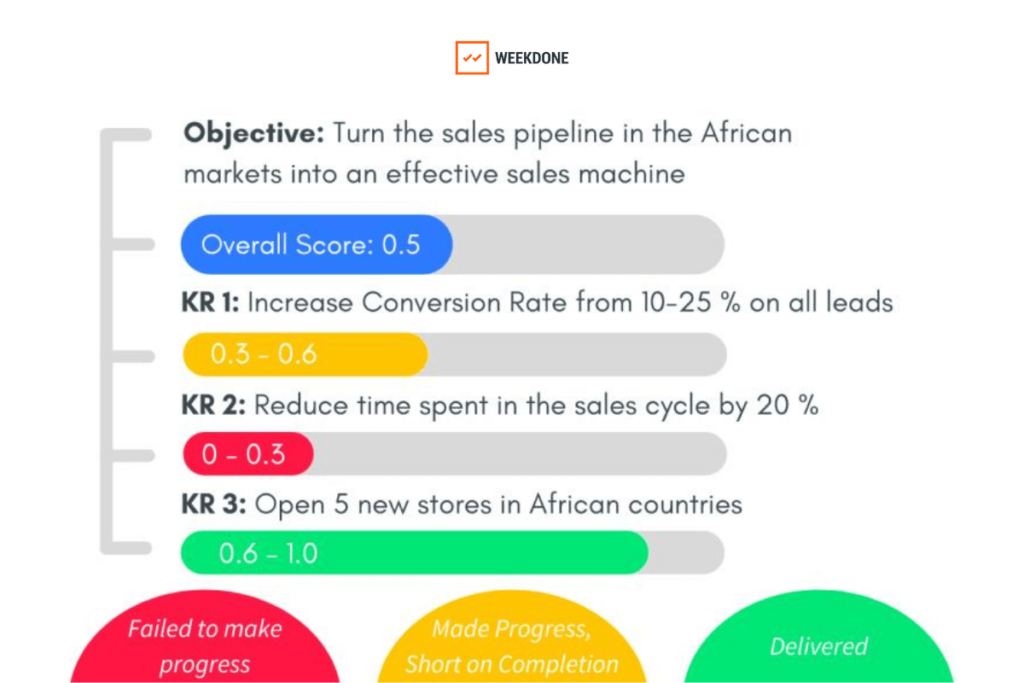Is your organization’s goal misalignment hindering you from achieving milestones and results? According to Andy Grove, the founding father of OKRs (Objectives and Key Results), engaging and aligning a team with OKR goals and knowing how to measure the expected outcomes of these objectives favors organizational growth.
Employees who feel that their goals align with an organization’s priorities are 3.5% more likely to be more engaged in their tasks. Unfortunately, many employees feel disengaged due to the lack of a practical goal-setting framework.
Fortunately, OKRs help business leaders and team managers to effectively align their teams, improve internal collaborations, and form the proper rhythm to achieve organizational growth.
Read further to properly define OKRs and understand how the OKR methodology works and benefits your organization.
What are OKR goals?
OKR goals are the objectives that a company formulates using the OKR framework. Further, the OKR —Objectives and Key Results—methodology is an advanced framework that takes goal setting to the next level by defining aspirational goals and their measurable expected results. OKRs are often highlighted for promoting a positive shift in organizational culture.
Success-oriented business leaders and team managers in prime companies—such as Adobe, Google, LinkedIn, Amazon, etc.—use OKRs to set practical, challenging, and ambitious goals and objectives with measurable results.
Components of OKRs
The key components of OKRs are:
- Objectives
- Key Results
Objectives
Objectives are simply what you want to achieve. By definition, an objective is concrete, significant, action-oriented, and typically inspirational.
Additionally, Objectives hinder indecisiveness and ineffective execution if properly designed and implemented.
Key Results
Key results monitor and benchmark how the company’s workforce achieves the pre-set goals. Efficient and practical Key Results tend to be specific, time-bound, realistic, and aggressive. More importantly, Key Results are verifiable and measurable.
At the end of each designated period (best practices suggest quarterly), a company can conduct a retrospective meeting to grade the results as achieved or not. You will achieve your Objective once you complete all Key Results.
In a nutshell, OKR focuses on the ends rather than the means. The methodology helps companies establish far-reaching goals in days rather than months. OKRs function similarly for setting goals throughout different organizational levels, whether office operations, nonprofits, or software engineering, among others.
A Brief History of OKR Framework
OKRs’ history traces back to 1954 when Peter Drucker invented Management By Objectives (MBO). During his time as CEO of Intel, Andrew Grove further developed Peter Drucker’s invention into the contemporary OKR.
Furthermore, in 1974—upon joining Intel—John Doerr learned more about OKR. He later joined Kleiner Perkins Caufield & Byers, a notable investor in Google’s history, and became an advisor in Google’s initial days. He introduced OKR to Larry Page and Sergey Brin, both Google founders, who went further to implement the methodology at Google.
Google is among the leading companies using OKRs to get results consistently. The company uses OKRs to plan what teams and individuals will work on.
Why does Google use OKRs?
- OKRs introduce clarity into the equation
- OKRs require focus and alignment
- OKRs promote consistent goal-setting and management
- They follow a standard formula.
Other companies besides Google constantly contributing to the history of the OKRs methodology include:
- American Global Logistics
- Baidu
- Asana
- Netflix
- Atlassian.
However, simply knowing about this framework doesn’t guarantee its success. For most organizations, properly understanding and implementing the OKR framework is key to unlocking the desired results.
OKR Methodology—How Does OKR Work?
Companies apply this methodology to align entire teams at organizational levels. The idea behind the OKR framework is that it formulates a central approach so that every member can strive towards a similar goal or objective.
How to Use OKRs
OKRs are relatively simple and flexible, depending on how you implement them within your company. They should align with the overarching organizational goal, drive enterprise initiatives, and include periodic check-ins to gauge progress.
Following OKR best practices, there should typically be 3-5 high-level objectives and extra 3-5 measurable key results for each objective. However, it isn’t advisable to have more than 5 OKRs at any particular time for large organizations (and a maximum of 3 for smaller organizations and teams).
It is vital to have a clear understanding of the challenges you want the OKR framework to solve and the benefits you expect. For most companies, OKRs solve the issue of strategy implementation and execution in a transparent, measurable, and clear manner for every party involved.
On one hand, OKR is a framework. On the other hand, it is also a learning process typically comprising a fundamental shift in how teams and individuals think about and gauge their work. More importantly, it facilitates the change of focus from output to intended outcomes.
The OKR Formula
Objectives and Key Results can be written with a goal (objective) at the top and 3-5 key results underneath. OKRs can also be written as statements. For instance:
“I will (Objective/Goal) as measured by (Key Results)”.
“I will delight our company clients as measured by an improved 97% customer retention rate”.
How Do You Grade OKRs?
Organizations should track OKRs regularly and score, or analyze them at the end of each cycle, often during a retrospective meeting. OKRs are typically formed on two cadences:
- Annually. Annual OKRs are essentially the organization’s long-term objective
- Quarterly. Quarterly OKRs are objectives set for teams and individuals.
There are various ways to grade OKRs. Andy Grove’s most common OKR grading method is the simple yes or no approach.
“Have you met the goal?” Or “Did you fail to meet the goal?”
Some companies prefer detailed grading, using red, green, and yellow colors. Under this grading system
- Red will mean “we failed to make progress”.
- Green will mean “we met and delivered on the objective”.
- Yellow will mean “we made progress but fell short on completion”.
Google’s grading method is more detailed. It uses a percentage scale (0.0- 1.0) to give key results number scores after each cycle. 1.0 typically means “complete”. Under this grading system, you will grade key results individually and average the scores to achieve the final OKR grade.
However, grading is just as vital as defining Objectives and Key Results. The grading results can reflect the fairness—or the lack of it—when setting goals and objectives.
For instance, consistently achieving high scores/grades may mean that the teams set easily achievable goals. In most cases, teams set easily achievable goals for fear that OKR grades are linked to performance reviews or financial bonuses. Unfortunately, this makes the organization’s goals inadequately ambitious.
📚 Read: OKRs are not a tool for performance management
But what OKR grade or score is good? An average of 0.6-0.7 is recommendable. Anything less than 0.6 translates to poor performance. Conversely, attaining 0.7-1.0 consistently can translate to less ambitious objectives.
OKR Goal Setting Process
The process occurs at three different levels:
1). Organizational
A company’s goal in OKR is often so high that a typical company considers 70% achievement to be a success. The leaders and managers at the organizational OKR level decide on a Company Objective for the quarter based on where there is room for improvement. Leadership defines this Objective for the organization, leaving teams to align their OKRs with that.
2). Team
Depending on each team’s specialization and function in a company, each will define together a Team Objective for the quarter along with related 3-5 Key Results for measuring progress. Team OKRs are the support system for the Company Objective, moving it in either direction during the quarter.
3). Individual
The above team OKRs are further divided and simplified into weekly deliverables, thus forming the foundation for individual OKRs. However, in Weekdone, we rather focus on “Weekly Plans”. This helps employees focus on goals as a team, supporting each other and that objective through specific and connected personal tasks. Individuals can also set Initiatives (longer-term projects, or activities) that help support the team OKRs and ultimately the Company Objective.
As you can see, the OKR goal-setting process is a logical and practical flow of goals and objectives connecting upper management to the lower tiers. However, it is worth noting that every member of this process flow is fundamental to the OKR process.
Goal achievement can happen from the bottom to the top level. Similarly, targets and progress can move across levels.
📚 Read: The OKR meaning for different company levels
How to Implement the OKR Framework
Implementing the OKR framework differs from the goal-setting process. Here are the four steps to ensure you get the most out of your OKR goals.
Define an Annual Objective
Where does your organization see itself in the next year? Determine the fundamental achievements that will direct the organization in the right direction while fostering an environment for growth and success. This overarching annual objective should derive from your company’s mission and vision.
Define Quarterly Objectives
The quarterly objectives will lead you accordingly since they serve as smaller, incremental objectives that function towards the larger global annual objective. However, ensure you set objectives that are fundamentally inspiring instead of being centered around metrics.
In addition, setting and defining objectives/goals isn’t easy. For maximum effectiveness, leaders and team managers should brainstorm and prioritize the vital objectives.
Define the Key Results
Defining 2-5 measurable key results will help you determine if you are heading in the right direction toward your goals. These are not activities to complete, rather they are the outcomes of those activities. They should be numeric, and help you measure the impact your actions are taking on your objective.
Assign Actions for Each Result
The actions you take to help move you closer to your objectives are called initiatives. Initiatives are any block of work that would take you longer than a week to complete. Likely, this project could take the whole quarter – but it is something actionable that drives your outcomes. Strive to have an initiative for each key result – this keeps your focus clear.
Start a company trial with unlimited users – invite your teams today!
Examples of OKRs
Below are practical examples of OKRs:
Example of Team OKR (Marketing Department)
OBJECTIVE
Improve the marketing system’s efficiency.
KEY RESULTS
1. Release three new marketing channels in Q1
2. Introduce an intelligent marketing automation system
3. Generate 200 more leads than the previous year with relatively the same budget.
Example of Team OKR (Sales Department)
OBJECTIVE
Hit Revenue of $20 million from new wins.
KEY RESULTS
1. Execute contracts worth $100 million
2. Generate 200 leads worth $200 million in Q1
3. Submit proposals worth $140 million by Q2.
Why Are OKRs Used? 8 Business Benefits of OKRs
Did you know that most successful organizations implement OKR as the leading goal-setting framework? Here are reasons you should consider OKRs for our organization too.
- The framework helps to capture cross-functional dependencies among individuals and across teams
- It improves resource allocation and management
- It helps to analyze the root causes of unachieved objectives
- It aligns and connects employees to corporate goals and objectives
- It elevates productivity via a focus on organizational goals
- The framework provides clear directs to teams and individuals
- It also helps to make more informed and effective decisions
- OKR is effective in setting clear and specific goals.
More importantly, the OKR framework helps companies attain its bottom line and increase scalability.
OKRs vs. SMART Goals
In his 1981 article, George T. Doran outlined the foundation for the concept of SMART goals. SMART goals is a common goal-setting approach fueled by managers and professionals across various industries.
SMART is an acronym for Specific, Measurable, Assignable, Realistic, and Time-related. However, upon comparison, OKRs differ from SMART goals extensively. Briefly, here’s how:
For starters, SMART goals can present fundamental differences from OKRs, depending on how individuals or teams define them contextually. On the one hand, OKR will always be Objectives and Key Results. On the other hand, when defining SMART, the ‘Assignable’ can be substituted for “Attainable”, “Measurement” substituted by “Motivation”, and “Realistic” replaced by “Relevant”.
SMART goals purely form the objective. Objectives and Key Results connect metrics to a pre-defined objective, strategically timed and allocation of resources. On the other hand, SMART goals are a list of principles to guide the formulation of objectives without focusing on tactics or key results.
Unlike OKR, SMART goals aren’t a framework but rather a guideline.
While both OKR and SMART goals share the element of inspiration and motivation, OKR carries weight in a strictly professional setting. It is more applicable in different organizational settings and levels, especially for its ability to tie objectives to key results and initiatives.
Dos and Don’ts of OKRs
Some OKR best practices include:
- Prioritize what is crucial to the company and set objectives that deliver results favoring your long-term bottom line.
- Define your objectives in tandem with the company’s core values.
- Include everyone in the OKR goal-setting process
- Support company, cross-departmental and team discussions through OKR check-ins on a weekly, monthly, and quarterly basis.
Things to avoid when implementing the OKR framework include:
- Setting too many goals and key results.
- Forming goals that aren’t time-bound.
- Confusing tasks with key results.
Are You Ready to Get Started with OKRs?
Efficient goal alignment supports a larger sense of engagement and purpose across an organization’s workforce. OKR framework is at the forefront of helping align company goals through key results and initiatives.
At Weekdone, we value the fundamental principles of proper alignment, structure, and connection. We can help your workforce feel more connected, from the ground up and vice versa.
We dedicate our time to helping organizations implement the concept of OKR. We’ll work to help you track OKRs effectively, share regular updates company-wide, and improve your overall organizational culture through a structured framework.
See if Weekdone is for you – Book a Demo



